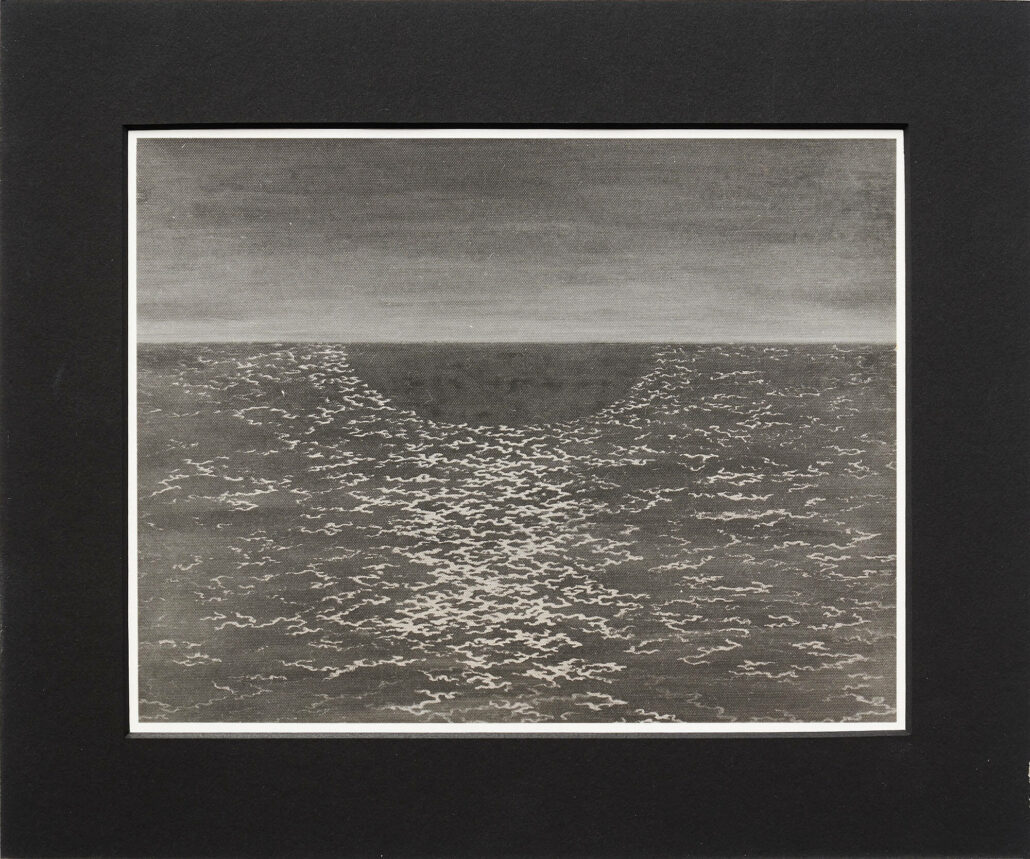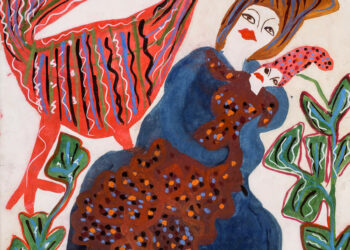‘Lala Rukh: In the Round’ reflects on three decades of the artist’s work produced against a backdrop of political and feminist movements in Pakistan

Lala Rukh, River in an ocean: 6, 1993. Image courtesy of the Estate of Lala Rukh and Grey Noise, Dubai
This February, Sharjah Art Foundation unveils ‘Lala Rukh: In the Round’, the first major international survey of the practice of the late artist, activist and pedagogue Lala Rukh (1948–2017). The exhibition reflects on three decades of her drawing, printmaking, photography and video, produced against the backdrop of political turmoil and feminist movements in Pakistan.
Among the 60 works on view, some from the Sharjah Art Foundation Collection, are original posters and publications from her activism, which are presented alongside archival materials and interviews with her collaborators in the fight for gender justice and civic rights. Also featured are rarely seen photographs and drawings, seascapes in different media, and her final piece, which brings together all of her previous interests and influences: abstraction, calligraphy and music.
Lala Rukh’s political posters, which served as powerful tools for social commentary, often chronicle moments of protest and resistance to repressive patriarchal policies. As a co-founder of the Women’s Action Forum (WAF), Lala Rukh was instrumental in mobilising and organising women against state oppression and gender-based discrimination. During the 1980s, WAF emerged as a critical voice advocating for women’s legal rights and equality in response to the repression of Pakistani dictator Zia ul Haq’s regime.
Lala Rukh was also a co-founder of Simorgh, a feminist collective in Pakistan that focused on research, publications and championing women’s issues. In Our Own Backyard, a manual published through the collective, popularised screenprinting and became a vital and accessible resource for spreading feminist ideas. It also formed the basis for several workshops that took place in the artist’s garden in Lahore. Lala Rukh’s dedication to teaching and pedagogy was well known, with her classroom and home in Lahore often becoming a hub for discussions, debates and learning.
In a later work, Subh-e-Umeed [Dawn of Hope] (2008), Lala Rukh encapsulates the charged essence of political activism in Pakistan through sound. Set against the backdrop of civil defiance, it reflects the period between 2007 and 2009, when lawyers, rejecting President Musharraf’s command, catalysed a movement that resonated with the country’s fight for democracy and the rule of law.
A number of rarely seen works form another important section of the exhibition. On view are photographs of everyday life, in both Pakistan and Chicago, that Lala Rukh took in the 1970s while studying for an MFA at the University of Chicago. Also included are her rarely seen Conté crayon drawings on paper. These untitled works depict the interplay between presence and absence as linear forms gradually recede into the space of the page.
Lala Rukh’s seascapes are another important part of this exhibition. The series ‘Sigiriya’ (1993), produced at the titular ancient rock fortress in Sri Lanka, depicts water bodies and their fluid rhythms. She experiments with screenprinting and pastels, keenly attending to the architectural symmetry of the site’s water garden and boulders encircled by dense fauna. Portraits of time, the works together reflect the horizon’s changing light from dawn to dusk.
Another series of works, including both prints and a video, was created in 2001 during a residency in the coastal town of Gadani, Pakistan. The works testify to her profound contemplation of the sea, particularly the impact of the nearby Gadani shipbreaking yards on the shoreline. Themes of natural cycles, ecological crisis and resilience converge and resonate throughout.
Water is also the focus of photographs taken by Lala Rukh between 1992 and 2005, in which she captures the liquid surfaces of multiple bodies of water across Sri Lanka, India, Nepal and Myanmar. Natural scenes unfold in locations that become the titles for each work – gentle ripples of water in Irrawady (XY) (2005); the glow of the setting sun in Beruwela 10, 11, 12 (1993) and Goa 1, 2, 3 (1993); and the gradual meandering of day into evening in North Sea (A, Z) (1994). In Pegasus Reef (1996), monochromatic photographs of wet sand resemble intricate grooves mapping the palms of hands.
‘In the Round’ also features Lala Rukh’s final work, Rupak (2016), exhibited for the first time in the region. Originally shown as part of documenta 14, the six-and-a-half-minute digital animation with sound, alongside 88 ink drawings, represents a seamless intertwining of mark making, musicality and silence. Lala Rukh’s practice was deeply influenced by Hindustani classical music, and this elaborate work of minimalist conceptualism draws from the seven-beat percussive terrain of the taal [rhythmic beat].
Viewed together, Lala Rukh’s artistic acts can be seen as defiant modes of time-keeping. This exhibition explores how the shaping of temporality takes varied forms across her life’s arc: the gradient of moonlight, a rising wave, tracings of coastal sands, collective reverberation in demonstrations of solidarity, and the lucid contours of a living body.
‘In the Round’ is curated by Hoor Al Qasimi, Director of Sharjah Art Foundation, and Natasha Ginwala, co-curator of Sharjah Biennial 16 and Artistic Director of COLOMBOSCOPE, with Mahmoud El Safadi, Assistant Curator at Sharjah Art Foundation.
The exhibition will be on view from the 24th of February until the 16th of June, 2024, at Galleries 1, 2 and 3, Al Mureijah Art Spaces, Sharjah. For more information, please visit the Sharjah Art Foundation.



